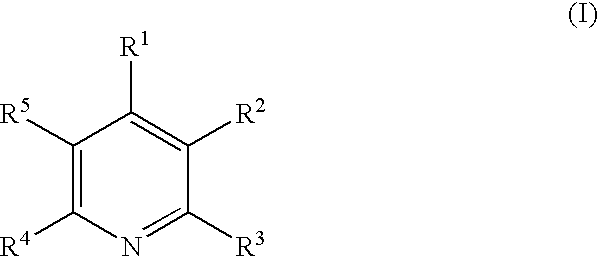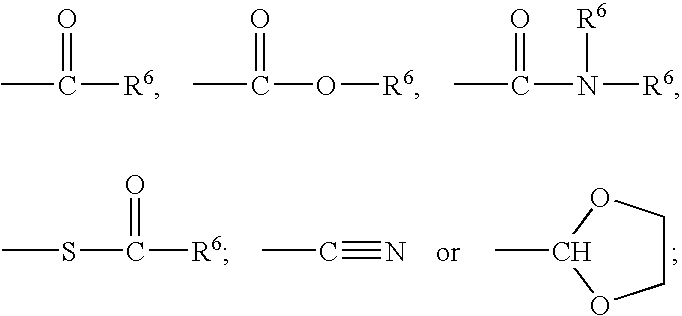Insect behaviour modifying compounds
a technology of insect behaviour and compound, applied in the field of insect behaviour modifying compound, can solve the problems of serious crop damage, pests that are a worldwide problem, damage to cultivated crops and plants, etc., and achieve the effect of preventing or minimising damage to plants
- Summary
- Abstract
- Description
- Claims
- Application Information
AI Technical Summary
Benefits of technology
Problems solved by technology
Method used
Image
Examples
example 1
Syntheses
[0175]Isopropyl sonicotinate.
[0176]A suspension of isonicotinic acid (Aldrich, 5 g) in oxalyl chloride (10.4 ml) was refluxed for 24 hours. Excess oxalyl chloride was removed by evaporation in vacuo to leave the acid chloride. Addition of isopropanol (20 ml, drop wise), standing at room temperature for 2 hours, then evaporation in vacuo gave the crude isopropyl nicotinate. Aqueous sodium bicarbonate solution (100 ml) was added, then the product extracted into dichloromethane (2×100 ml). This was dried, then evaporated in vacuo to give isopropyl isonicotinate [Registry No. 125294-42-0] as a creamy white, oily looking solid (5.60 g, 83%): UV (methanol) λmax (log ε) 212 (3.95), 274 (3.43) nm.
[0177]Propyl Isonicotinate.
[0178]Isonicotinic acid (Aldrich, 10 g) was refluxed with excess thionyl chloride (50 ml) for one hour. Excess thionyl chloride was removed by evaporation in vacuo to leave the acid chloride. Propanol (12.5 ml) was added and stirred for 30 minutes. Aqueous sodium...
example 2
Field Trials
[0189]Water traps were placed out into a field comprising several species of grasses, white clover (Trifolium repens L.) and several weed species (≈100 mm in height). Grass and cereal fields surrounded the field trial area on three sides and poplar (Poplar nigra L.) trees on the other, on the Canterbury Agricultural Research Centre campus. Each field trial consisted of five replicates of five treatments including a water control, positive control compound (ethyl nicotinate, ethyl isonicotinate, or benzaldehyde, Table 1) and three test compounds set out in the field in a grid (10×10 m) using a Latin square design with the trial area at least 100 m from the field boundary / shelter belt. White plastic containers (2 L capacity, 16×16×8.5 cm) containing approximately 1.7 L water, 0.4 ml of formalin (to prevent fungal growth) and 0.08 ml tween were placed above the crop canopy on inverted white (2 L capacity, 16×16×8.5 cm) or black plastic containers (24 cm diameter, 13 cm tall...
example 3
Y-tube Olfactometer
[0191]The olfactory behaviour of thrips toward volatile compounds was evaluated in a glass Y-tube olfactometer following the method described by de Kogel et al. (de Kogel, W. J., Koschier, E. H. and Visser, J. H. Proc. Exper. &Appl. Entomol., N. E. V. Amsterdam, (1999) 10, 131-135.) and Koschler et al. (Koschier, E. H., De Kogel, W. J. and Visser, J. H. (2000) Journal of Chemical Ecology, 26, 2643-2655.). The Y-tube has two branching arms at an angle of 45° leading into a single tube, all 60 mm long, with an internal diameter of 5 mm. The arms of the Y-tube were connected to glass Wheaton Micro Kit® adapters that were in turn attached to 4 ml glass vials each containing a 1 cm2 piece of filter paper (Whatman No. 1). The Y-tube and Wheaton apparatus were placed in a grey-box (to prevent external stimuli influencing thrips' behaviour), located in a darkened, air-conditioned room (22±3° C.). The Y-tube was placed at an inclining position of 25° between the Y-tube and...
PUM
| Property | Measurement | Unit |
|---|---|---|
| transparent | aaaaa | aaaaa |
| temperature | aaaaa | aaaaa |
| height | aaaaa | aaaaa |
Abstract
Description
Claims
Application Information
 Login to View More
Login to View More - R&D
- Intellectual Property
- Life Sciences
- Materials
- Tech Scout
- Unparalleled Data Quality
- Higher Quality Content
- 60% Fewer Hallucinations
Browse by: Latest US Patents, China's latest patents, Technical Efficacy Thesaurus, Application Domain, Technology Topic, Popular Technical Reports.
© 2025 PatSnap. All rights reserved.Legal|Privacy policy|Modern Slavery Act Transparency Statement|Sitemap|About US| Contact US: help@patsnap.com



